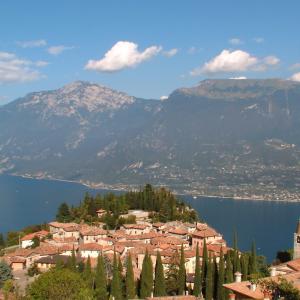Pieve is the most important village in the municipality of Tremosine sul Garda, and it is part of I Borghi più belli d’Italia, an association gathering the most beautiful villages in Italy. The village is located at an altitude of 413 meters above sea level, on top of a cliff excavated by a glacier, directly overlooking Lake Garda.
Pieve, from the Neolithic to the 19th century
The name of the village, from the Latin "plebs", meaning people, indicates that Pieve was once the civil and religious center of Tremosine sul Garda and its surrounding villages, as it is recognized and documented in a 1186 bull by Pope Urban III.
Pieve’s history stretches back millennia - according to some, the village was inhabited since the Neolithic age, when the first communities settled in places named Castello and Liss. From the Neolithic period onwards, there is no other documented evidence of continuous settlement until Roman times, although it is thought that the village was always inhabited. Many tombstones found throughout Tremosine sul Garda date back to the Roman period, as does the stone placed on the wall of the parish church in the village.
The first Christian chapel was built in the 8th-9th century. It was demolished towards the end of the year 1000 to leave space for a larger Romanesque church dedicated to Santa Maria, recognized in the 12th century as the religious and social centre of the region.
Around 1570 the Romanesque church was demolished to build a new, larger structure dedicated to San Giovanni Battista, with paintings dating back to the 17th-18th century.
The road to the lake
For centuries, Pieve di Tremosine sul Garda was connected to its surrounds and to Lake Garda only by mule tracks and narrow paths, like the scenic Porto-Pieve Trail. Three rope cableways were built only between the late nineteenth and early twentieth century, connecting the village to the shores of the lake. One of the stations was located near the church, towards the south near a crack in the rock, another was on Piazza Arturo Cozzaglio, and the last one to be built was on the churchyard. Finally, in 1913, the Porto-Pieve-Vesio road was opened, known today as Strada della Forra. The patron saint’s day in Pieve is celebrated on June 24th.
A short walking tour through Pieve di Tremosine sul Garda
Crossing Pieve di Tremosine sul Garda means discovering its past, looking at the magnificent Scala Tonda and then crossing Piazza Cozzaglio on the way to the many balconies overlooking the lake. Don’t miss visiting the Must to learn about the history of the Tremosine sul Garda plateau, enjoying an aperitif at the famous Terrazza del Brivido and hiking the Porto-Pieve trail, if you’re feeling active.





